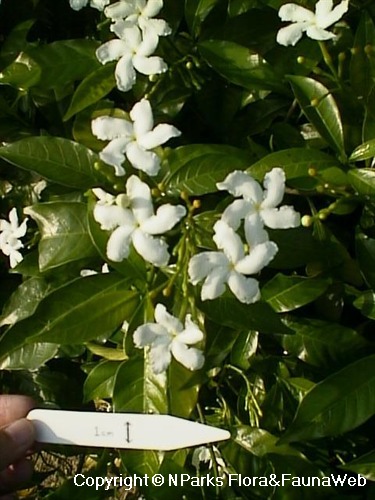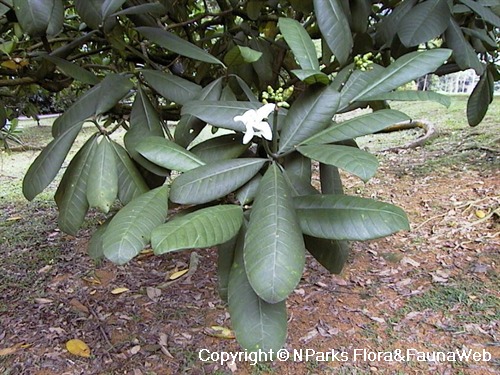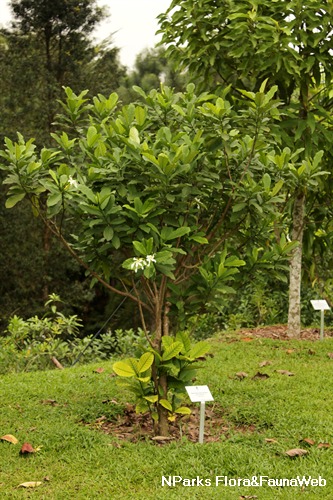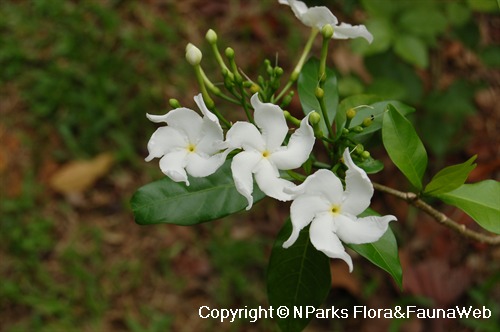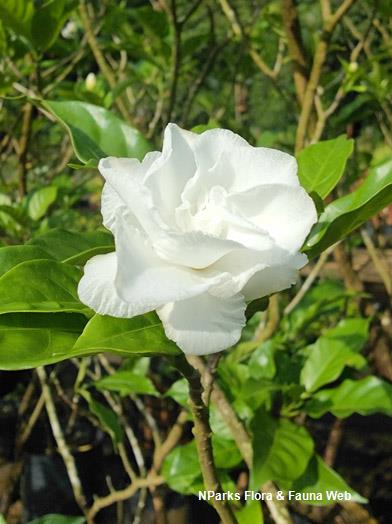.jpg)
Back
Tabernaemontana divaricata (L.) R.Br. ex Roem. & Schult.
| Family Name: | Apocynaceae |
| Synonyms: | Tabernaemontana coronaria, Ervatamia divaricata, Tabernaemontana citrifolia, Tabernaemontana discolor |
| Common Name: | Pinwheel Flower, East Indian Rosebay, Moon Beam, Ceylon Jasmine, Susun Kelapa, Susoh Ayam, Crepe Jasmine, Crepe Gardenia, Adam's Apple, Nero's Crown, Coffee Rose, Jelutong Badak |
Tabernaemontana divaricata (Pinwheel Flower) is an evergreen round shrub with large, glossy dark green leaves and waxy, white flowers. Its flower petals are twisted like pinwheels and are fragrant, especially at night.
Name
Classifications and Characteristics
| Plant Division | Angiosperms (Flowering Seed Plants) (Dicotyledon) |
|---|---|
| Plant Growth Form | Shrub |
| Lifespan (in Singapore) | Perennial |
| Mode of Nutrition | Autotrophic |
| Plant Shape | Shrubby |
| Maximum Height | 0.5 m to 2 m |
| Maximum Plant Spread / Crown Width | 1 m to 1.8 m |
Biogeography
| Native Distribution | Assam, Bangladesh, South-Central China, East and West Himalaya, India, Nepal, Cambodia, Laos, Myanmar, Thailand, Vietnam |
|---|---|
| Native Habitat | Terrestrial |
| Preferred Climate Zone | Tropical |
| Local Conservation Status | Non-native (Horticultural / Cultivated Only) |
Description and Ethnobotany
| Growth Form | Small shrub with a broad surface, able to grow up to about 2 m tall. |
|---|---|
| Foliage | Dark green, glossy leaves are oval with a wavy leaf margin, measuring about 15 cm long and 5 cm wide. |
| Stems | Smooth stem |
| Flowers | White and fragrant 5-petaled tubular flowers are shaped like pinwheels, petal tips are twisted to the left in a counterclockwise direction. Flowers are arranged in clusters known as cymes. Flower buds are oval-shaped. |
| Fruit | Fruit is an inconspicuous dry and hard pod called follicles. |
| Others - Plant Morphology | Plant exudes a milky latex when parts of it are broken. |
| Habitat | Found in montane brushwoods and sparse forests. |
| Cultivation | Plant flowers best when grown under full sun on well-drained, moist soils. Plants can be propagated via stem cuttings. |
| Etymology | Genus Tabernaemontana is named after Jakob Theodor von Bergzaben (1520 - 1590) (Latinised surname Tabernaemontanus meaning "tavern in the mountain"), who was a German herbalist. Species divaricata means wide-spreading or divaricate. |
| Ethnobotanical Uses | Medicinal: The roots, leaves and flowers are used in some parts of China for snake and scorpion poisoning. |
Landscaping Features
| Landscaping | Commonly grown in landscapes for its ornamental pinwheel-shaped flowers and large glossy leaves. Plant is hardy and is free-flowering all year round, grown in container planting, as hedge or for general use in parks and gardens. |
|---|---|
| Desirable Plant Features | Ornamental Flowers, Fragrant |
| Landscape Uses | Container Planting, Flowerbed / Border, General, Parks & Gardens, Small Gardens |
| Usage Hazard - Cons | Toxic Upon Ingestion |
Fauna, Pollination and Dispersal
| Fauna Pollination Dispersal Associated Fauna | Butterfly-Attracting, Moth Food Plant |
|---|---|
| Pollination Method(s) | Biotic (Fauna) (Insects (Butterfly, Moth)) |
Plant Care and Propagation
| Light Preference | Full Sun, Semi-Shade |
|---|---|
| Water Preference | Moderate Water |
| Plant Growth Rate | Moderate |
| Rootzone Tolerance | Easy to Grow, Moist Soils, Well-Drained Soils |
| Propagation Method | Stem Cutting |
Foliar
| Foliage Retention | Evergreen |
|---|---|
| Mature Foliage Colour(s) | Green |
| Mature Foliage Texture(s) | Glossy / Shiny, Raised / Sunken Veins |
| Prominent Young Flush Colour(s) | Green |
| Young Flush Texture(s) | Glossy / Shiny |
| Foliar Type | Simple / Unifoliate |
| Foliar Arrangement Along Stem | Spiral |
| Foliar Attachment to Stem | Petiolate |
| Foliar Shape(s) | Non-Palm Foliage (Oval) |
| Foliar Venation | Pinnate / Net |
| Foliar Margin | Entire - Wavy / Undulate |
| Foliar Apex - Tip | Apiculate |
| Foliar Base | Attenuate |
| Typical Foliar Area | Microphyll ( 2.25cm2 - 20.25 cm2 ) |
| Leaf Area Index (LAI) for Green Plot Ratio | 4.5 (Shrub & Groundcover - Dicot) |
Non - Foliar and Storage
| Trunk Type (Non Palm) | Woody |
|---|---|
| Mature Bark Texture | Smooth |
| Stem Type & Modification | Woody |
| Root Type | Underground |
Floral (Angiosperm)
| Flower & Plant Sexuality | Bisexual Flowers |
| Flower Colour(s) | White |
|---|---|
| Flower Texture(s) | Smooth |
| Flower Grouping | Cluster / Inflorescence |
| Flower Location | Terminal |
| Flower Symmetry | Radial |
| Individual Flower Shape | Stellate / Star-shaped, Tubular |
| Inflorescence Type | Cyme |
| Flowering Period | Free-Flowering |
| Flowering Habit | Polycarpic |
Fruit, Seed and Spore
| Fruit Classification | Simple Fruit |
|---|---|
| Fruit Type | Dehiscent Dry Fruit , Follicle |
References
| References | Polunin, Ivan. 2010. Plants and Flowers of Singapore. Malaysia: Marshall Cavendish Editions . |
|---|
Image Repository
Others
| Master ID | 1195 |
|---|---|
| Species ID | 2488 |
| Flora Disclaimer | The information in this website has been compiled from reliable sources, such as reference works on medicinal plants. It is not a substitute for medical advice or treatment and NParks does not purport to provide any medical advice. Readers should always consult his/her physician before using or consuming a plant for medicinal purposes. |


